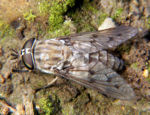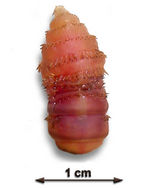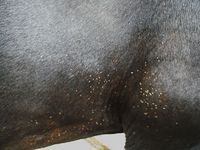Difference between revisions of "Gasterophilus spp."
| (35 intermediate revisions by 3 users not shown) | |||
| Line 1: | Line 1: | ||
| − | [[Image:Horse Bot Fly.jpg|thumb|right|150px|Horse Bot Fly | + | {{OpenPagesTop}} |
| + | {{Taxobox | ||
| + | |name =''Gasterophilus spp. | ||
| + | |kingdom = Animalia | ||
| + | |phylum = [[:Category:Arthropods|Arthropoda]] | ||
| + | |class =[[:Category:Insecta|Insecta]] | ||
| + | |sub-class = Diptera | ||
| + | |order = | ||
| + | |super-family = | ||
| + | |family =[[Oestridae]] | ||
| + | |sub-family = | ||
| + | |genus = Gasterophilus | ||
| + | |species = | ||
| + | }} | ||
| + | [[Image:Horse Bot Fly.jpg|thumb|right|150px|''Horse Bot Fly'' <br> Dennis Ray 2005, Wikimedia Commons]] | ||
| + | Also known as: '''''Bot Fly — Bots''' | ||
| − | + | ==Introduction== | |
| − | The species Gasterophilus, is more commonly referred to as the 'Bot fly.' It is an obligate parasite found on horses, donkeys, mules, zebras and elephants. | + | The species ''Gasterophilus'' is of the family [[Oestridae]], and is more commonly referred to as the 'Bot fly.' It is an obligate parasite found on horses, donkeys, mules, zebras and elephants. |
Infection is particularly common in horses, with around 30-60% infected during the winter months. | Infection is particularly common in horses, with around 30-60% infected during the winter months. | ||
Within the United Kingdom there are three species of veterinary importance; | Within the United Kingdom there are three species of veterinary importance; | ||
| − | ''G. intestinalis'' which is the most common,''G. nasalis'', and''G. haemorrhoidalis'' which | + | ''G. intestinalis'' which is the most common, and ''G. nasalis'', and ''G. haemorrhoidalis'' which are rare. |
| − | ''G. nigricornis'' and''G. inermis'' are also of veterinary significance, but not currently within the UK. | + | ''G. nigricornis'' and ''G. inermis'' are also of veterinary significance, but not currently within the UK. |
| − | '' | + | [[Image:Gasterophilus larvae.jpg|150px|thumb|right|''Gasterophilus larvae'' <br> Lamiot 2007, Wikimedia Commons]] |
| − | + | ==Identification== | |
| − | + | Gasterophilus are medium to large flies at 10-20mm long, and are thought to look similar to drone bumble bees. | |
| − | |||
| − | |||
| − | |||
| − | |||
| − | |||
| − | |||
| − | |||
| − | |||
| − | |||
| − | |||
| − | |||
| − | |||
| − | |||
| − | |||
| − | |||
| − | |||
| − | |||
| − | |||
| − | |||
| − | + | They have clear wings with brown patches, and produce creamy-white eggs, around 1-2mm in length | |
| − | + | Adults have non-functional mouthparts so cannot feed. | |
| − | + | Both ''G. haemorrhoidalis'' and ''G. nasalis'' have spikes on the ventral surface of the larval segments arranged in two rows. ''G. intestinalis'' have mouth parts that are not uniformly curved dorsally and the body spikes present have blunt ended tips. | |
| − | + | ==Life Cycle== | |
| − | Eggs are laid on the | + | Eggs are laid on the body of the host and either hatch spontaneously or are stimulated to hatch through an increase in warmth and moisture from the animal self-grooming. They are laid in different areas according to species; |
| − | ''G. intestinalis'' eggs are laid in the hair of the shoulders and | + | ''G. intestinalis'' eggs are laid in the hair of the shoulders and forelegs. ''G. nasalis'' eggs are laid in the intermandibular area. ''G. haemorrhoidalis'' eggs are laid around the lips |
| + | L1 are extremely small and motile, and begin development in the mouth, tongue and gums of the host. The development of L1 into L2 occurs on the pharynx. L2 then attaches to the base of the tongue and slowly migrates to the stomach. | ||
| − | + | L3 attaches to the squamous gastric mucosa along the margo plicatus, in the case of ''G. intestinalis''. ''G. nasalis'' attaches to the dorsoproximal part of the duodenum, and ''G. haemorrhoidalis'' attaches to the gastric epithelium within the stomach. | |
| − | + | The larvae then remain and develop within the stomach for around 10-12 months. They mature in the following spring or early summer (generally between May and September), detach from their surface and are passed out in the host faeces. ''G. haemorrhoidalis'' also attaches to the rectal mucosa before being passed out. | |
| + | [[Image:Gasterophilus.jpg|200px|thumb|right|''Gasterophilus'' <br> Notafly 2008, Wikimedia Commons]] | ||
| − | + | The larvae then penetrate the soil, where they transform into pupae and the flies hatch 30 to 40 days later. | |
| − | + | They are only found on pasture, as they do not survive well on stable bedding. The pupae are known to be sensitive to frost, moisture and flooding, so the environmental conditions present play a significant role in the success of the parasite. | |
| − | |||
| − | + | {{Learning | |
| + | |flashcards = [[Myiasis_Producing_Flies_Flashcards|Myiasis Producing Flies Flashcards]] | ||
| + | |literature search =[http://www.cabdirect.org/search.html?q=title%3A%28%22Gasterophilus%22%29+ ''Gasterophilus'' spp. publications] | ||
| + | |Vetstream = [https://www.vetstream.com/canis/Content/Disease/dis60301.asp Myiasis] | ||
| + | }} | ||
| − | |||
| − | + | {{review}} | |
| + | {{OpenPages}} | ||
[[Category:Oestridae]] | [[Category:Oestridae]] | ||
| − | [[Category: | + | |
| + | |||
| + | [[Category:Expert_Review]] | ||
| + | [[Category:Horse Parasites]] | ||
Latest revision as of 17:32, 4 June 2016
| Gasterophilus spp. | |
|---|---|
| Kingdom | Animalia |
| Phylum | Arthropoda |
| Class | Insecta |
| Sub-class | Diptera |
| Family | Oestridae |
| Genus | Gasterophilus |
Also known as: Bot Fly — Bots
Introduction
The species Gasterophilus is of the family Oestridae, and is more commonly referred to as the 'Bot fly.' It is an obligate parasite found on horses, donkeys, mules, zebras and elephants.
Infection is particularly common in horses, with around 30-60% infected during the winter months.
Within the United Kingdom there are three species of veterinary importance; G. intestinalis which is the most common, and G. nasalis, and G. haemorrhoidalis which are rare.
G. nigricornis and G. inermis are also of veterinary significance, but not currently within the UK.
Identification
Gasterophilus are medium to large flies at 10-20mm long, and are thought to look similar to drone bumble bees.
They have clear wings with brown patches, and produce creamy-white eggs, around 1-2mm in length
Adults have non-functional mouthparts so cannot feed.
Both G. haemorrhoidalis and G. nasalis have spikes on the ventral surface of the larval segments arranged in two rows. G. intestinalis have mouth parts that are not uniformly curved dorsally and the body spikes present have blunt ended tips.
Life Cycle
Eggs are laid on the body of the host and either hatch spontaneously or are stimulated to hatch through an increase in warmth and moisture from the animal self-grooming. They are laid in different areas according to species; G. intestinalis eggs are laid in the hair of the shoulders and forelegs. G. nasalis eggs are laid in the intermandibular area. G. haemorrhoidalis eggs are laid around the lips
L1 are extremely small and motile, and begin development in the mouth, tongue and gums of the host. The development of L1 into L2 occurs on the pharynx. L2 then attaches to the base of the tongue and slowly migrates to the stomach.
L3 attaches to the squamous gastric mucosa along the margo plicatus, in the case of G. intestinalis. G. nasalis attaches to the dorsoproximal part of the duodenum, and G. haemorrhoidalis attaches to the gastric epithelium within the stomach.
The larvae then remain and develop within the stomach for around 10-12 months. They mature in the following spring or early summer (generally between May and September), detach from their surface and are passed out in the host faeces. G. haemorrhoidalis also attaches to the rectal mucosa before being passed out.
The larvae then penetrate the soil, where they transform into pupae and the flies hatch 30 to 40 days later.
They are only found on pasture, as they do not survive well on stable bedding. The pupae are known to be sensitive to frost, moisture and flooding, so the environmental conditions present play a significant role in the success of the parasite.
| Gasterophilus spp. Learning Resources | |
|---|---|
To reach the Vetstream content, please select |
Canis, Felis, Lapis or Equis |
 Test your knowledge using flashcard type questions |
Myiasis Producing Flies Flashcards |
 Search for recent publications via CAB Abstract (CABI log in required) |
Gasterophilus spp. publications |
| This article has been peer reviewed but is awaiting expert review. If you would like to help with this, please see more information about expert reviewing. |
Error in widget FBRecommend: unable to write file /var/www/wikivet.net/extensions/Widgets/compiled_templates/wrt693be84cd380e4_31839019 Error in widget google+: unable to write file /var/www/wikivet.net/extensions/Widgets/compiled_templates/wrt693be84cd8f779_66188677 Error in widget TwitterTweet: unable to write file /var/www/wikivet.net/extensions/Widgets/compiled_templates/wrt693be84cdf7626_44344191
|
| WikiVet® Introduction - Help WikiVet - Report a Problem |


